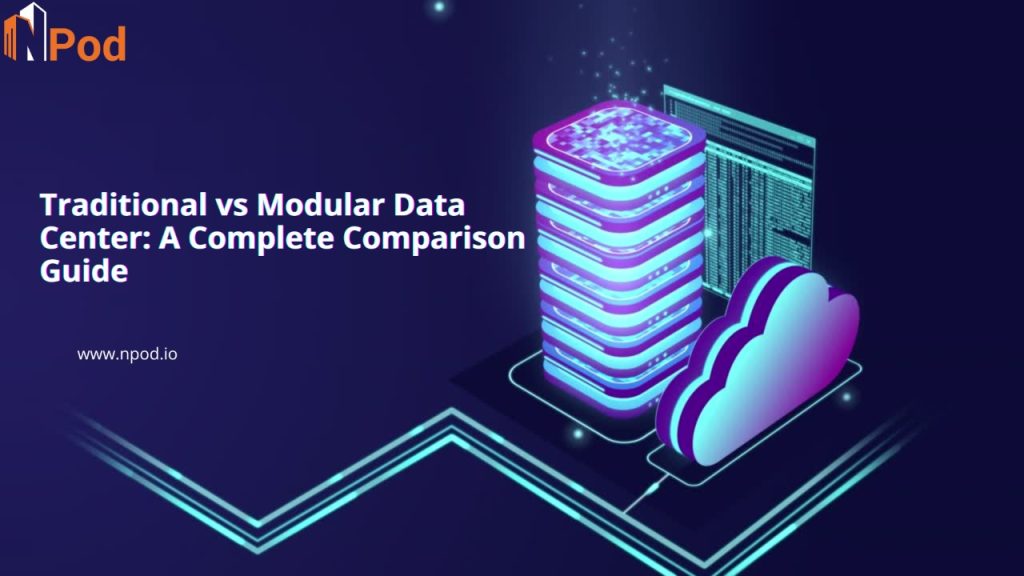In the data-driven world of today, companies greatly depend on strong IT infrastructure. Your choice of data center design may make or break operational effectiveness, regardless of whether you’re a startup expanding operations or an enterprise managing heavy workloads. Modular data centers and traditional data centers are two of the most popular varieties. However, what differentiates them? Which one is best for your company?
To help you in making an informed choice, let’s explore it in our complete comparison guide.
What is a Traditional Data Center?
An actual building that is constructed from the ground up is called a traditional data center. These centers are specialized and usually found in expansive enterprise hubs or on a company’s property. They are made of steel, concrete, and brick and are intended to hold networking devices, servers, storage systems, power units, and cooling infrastructure.
Key Features of Traditional Data Centers:
- Permanent infrastructure with a fixed layout.
- Designed for durability for many years.
- Requires a large initial investment of funds.
- Lengthy deployment period (often 12–24 months).
- Tailored to meet particular organizational requirements.
- High maintenance costs and energy use.
What is a Modular Data Center?
A modular data center is constructed utilizing quickly transportable, deployable, and scalable prefabricated modules or pieces. These modules have all the required parts, including power, cooling, and IT infrastructure, pre-engineered. They are easy to install and can be placed almost anywhere, including in isolated or disaster-prone locations.
Key Features of Modular Data Centers:
- Quick deployment—weeks as opposed to months.
- Reduced initial and ongoing expenses.
- Easily expandable with additional modules.
- Cooling that is optimized and uses less energy.
- standardized but subject to change if necessary.
What is the Difference Between Modular and Traditional Data Center?
A common query among IT executives is, what distinguishes a traditional data center from a modular one? Although housing and managing IT workloads is their primary function, their design ideas and operating methods differ significantly.
Key Differences:
- Deployment Duration
Traditional: It takes months or even years to construct and start up.
Modular: Because of outside prefabrication, it can be installed in a few weeks.
- The ability to scale
Traditional: Needs significant infrastructure changes and improvements; has limited scalability.
Modular: highly scalable; as your data needs increase, add more modules.
- The Cost Framework
Traditional: High operational and capital expenditures (CapEx and OpEx).
Modular: Affordable because of standardization and lower building expenses.
- Flexibility in Location
Traditional: Needs stable environmental conditions and fixed infrastructure.
Modular: Suitable for temporary setups or difficult locations.
- Efficiency in Energy Use
Traditional: Because of outdated systems, it is frequently inefficient.
Modular: Made to maximize airflow, use less energy, and be environmentally friendly.
- Maintenance
Traditional: Needs frequent, manual maintenance, which increases downtime.
Modular: Features easy component replacement and remote monitoring capabilities.
- Recovery from Disasters
Traditional: Sensitive to hazards unique to a certain location, such as fire, earthquakes, or floods.
Modular: Simple to move or copy for backup in various locations.
Benefits of Modular Data Center Over Traditional Setup
Still confused as to why businesses are moving toward modular configurations? Let’s examine the main benefits of modular data center systems:
- Faster Time-to-Market: Get up and running in weeks instead of years.
- Lower Upfront Investment: Spend less up front and still achieve the same or greater results.
- Portability: Relocate your data center to edge locations, remote sites, or short-term initiatives as needed by the business.
- Sustainability: improved PUE (Power Usage Effectiveness), reduced energy use, and environmentally friendly cooling options.
- Risk Reduction: For improved business continuity, just make backups or duplicates in several locations.
- Easy Expansion: As your company expands, add modules without having to rebuild the entire building.
The Future of Data Centers
Today, speed and flexibility are necessary, not optional. For this reason, NPOD and similar solutions are revolutionizing the deployment of data centers.
NetForChoice’s next-generation modular data center solution, NPOD, was created to satisfy the expectations of contemporary businesses in real time. Because of its robustness, scalability, and portability, you can quickly and easily establish an enterprise-class data center anywhere in India. NPOD enables you to create edge computing for IoT/AI, extend into rural areas, or require temporary disaster recovery infrastructure with:
- Modular design that has been pre-engineered
- Integrated fire safety and security
- Features for intelligent monitoring and control
- Power and cooling systems that are optimized
Conclusion
The decision between a modular data center and a traditional data center ultimately comes down to your deployment requirements, money, and business objectives. Large businesses with consistent, long-term demands might still benefit from traditional data centers. However, modular data centers are definitely the way to go for businesses looking for agility, rapid growth, and reduced operating risks.
Adopting adaptable and future-ready infrastructure is becoming essential as the digital economy picks up speed. And NPOD assists you in taking the initiative in that situation.
FAQs:
- What differentiates a traditional data center from a modular one?
Traditional data centers are permanent, custom-built structures that take a lot of time and money to construct, whereas modular data centers are prefabricated, portable, and expandable components.
- Are modular data centers reliable for enterprise use?
Yes, they are constructed using enterprise-grade components and provide security features, redundancy, and dependable performance on par with traditional centers.
- Is it possible to customize modular data centers?
Of course. Modular data centers can be customized to meet particular business and regulatory requirements even if they are based on standardized designs.
- How can I choose the best model for my company?
Consider your budget, schedule, scalability requirements, and geographical difficulties when making your assessment. While traditional works well for steady, long-term deployments, modular is ideal for operations that are dynamic, rapidly expanding, or remote.
